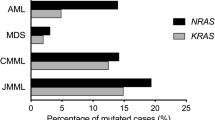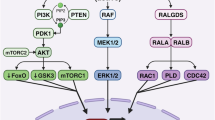Abstract
Ras is a major signaling molecule activated by interleukin-6. There have been no published reports, however, that specifically examine the kinetics and percentage of Ras activation in response to IL-6. Model cell lines were used to study activation of N- and K-ras induced by IL-6. All of the myeloma cell lines we tested express both N-ras and K-ras, but not H-ras. GTP-bound Ras was measured and the percentage of the total Ras pool that was activated in response to IL-6 was calculated. IL-6 is able to transiently activate both N- and K-ras in the ANBL6 cell line. In addition, increasing concentrations of IL-6 are able to activate increasing levels of both N- and K-ras. One ng/ml of IL-6 is able to activate approximately 10% of the N-ras pool and 18% of the K-ras pool. The amount of Ras-GTP in the cells correlates with the level of proliferation at low levels, but proliferation plateaus when higher levels of Ras-GTP are present. Protection from dexamethasone-induced apoptosis correlates with IL-6 concentration and Ras activation. However, IL-6 enhances apoptosis induced by doxorubicin. Interestingly, the ANBL6 cell line transfected with an N-ras12 or a K-ras12 gene is protected from doxorubicin-induced apoptosis.
This is a preview of subscription content, access via your institution
Access options
Subscribe to this journal
Receive 50 print issues and online access
$259.00 per year
only $5.18 per issue
Buy this article
- Purchase on SpringerLink
- Instant access to full article PDF
Prices may be subject to local taxes which are calculated during checkout






Similar content being viewed by others
References
Bataille R, Jourdan M, Zhang XG, Klein B . 1989 J. Clin. Invest. 84: 2008–2011
Billadeau D, Jelinek DF, Shah N, LeBien TW, Van Ness B . 1995 Cancer Res. 55: 3640–3646
Billadeau D, Liu P, Jelinek D, Shah N, LeBien TW, Van Ness B . 1997 Cancer Res. 57: 2268–2275
Brownell HL, Firth KL, Kawauchi K, Delovitch T, Raptis L . 1997 DNA Cell. Biol. 16: 103–110
Chauhan D, Pandey P, Ogata A, Teoh G, Krett N, Halgren R, Rosen S, Kufe D, Kharbanda S, Anderson K . 1997a J. Biol. Chem. 272: 29995–29997
Chauhan D, Pandey P, Ogata A, Teoh G, Treon S, Urashima M, Kharbanda S, Anderson KC . 1997b Oncogene 15: 837–843
Corradini P, Ladetto M, Voena C, Palumbo A, Inghirami G, Knowles DM, Boccadoro M, Pileri A . 1993 EMBO J. 16: 6439–6451
Hall A . 1998 Science 280: 2074–2075
Hardin J, MacLeod S, Grigorieva I, Chang R, Barlogie B, Xiao H, Epstein J . 1994 Blood 84: 3063–3070
Hata Y, Natsumeda Y, Weber G . 1993 Oncol. Res. 5: 161–164
Hirano T, Nakajima K, Hibi M . 1997 Cytokine Growth Factor Rev. 8: 241–252
Jones MK, Jackson JH . 1998 J. Biol. Chem. 273: 1782–1787
Kawano M, Hirano T, Matsuda T, Taga T, Horii Y, Iwato K, Asaoku H, Tang B, Tanabe O, Tanaka H, Kuramoto A, Kishimoto T . 1988 Nature 332: 83–85
Klein B, Zhang XG, Jourdan M, Content J, Houssiau F, Aarden L, Piechaczyk M, Bataille R . 1989 Blood 73: 517–526
Lichtenstein A, Tu Y, Fady C, Vescio R, Berenson J . 1995 Cell. Immunol. 162: 248–255
Liu P, Leong T, Quam L, Billadeau D, Kay NE, Greipp P, Kyle RA, Oken MM, Van Ness B . 1996 Blood 88: 2699–2706
McCloskey TW, Oyaizu N, Coronesi M, Pahwa S . 1994 Clin. Immunol. Immunopathol. 71: 14–18
McCormick F . 1996 Nat. Struct. Biol. 3: 653–655
Nakafuku M, Satoh T, Kaziro Y . 1992 J. Biol. Chem. 267: 19448–19454
Neri A, Murphy JP, Cro L, Ferrero D, Tarella C, Baldini L, Dalla-Favera R . 1989 J. Exp. Med. 170: 1715–1725
Paquette RL, Berenson J, Lichtenstein A, McCormick F, Koeffler HP . 1990 Oncogene 5: 1659–1663
Portier M, Moles JP, Mazars GR, Jeanteur P, Bataille R, Klein B, Theillet C . 1992 Oncogene 7: 2539–2543
Rowley M, Liu P, Van Ness B . 2000 Blood 96: 3175–3180
Takai Y, Sasaki T, Matozaki T . 2001 Physiol. Rev. 81: 153–208
Taylor SJ, Shalloway D . 1996 Curr. Biol. 6: 1621–1627
Acknowledgements
We wish to thank Richard Roof and the Daniel Mueller lab for reagents and technical support for the activated Ras interaction assay. This work was supported by the National Institutes of Health grant P01CA62242.
Author information
Authors and Affiliations
Corresponding author
Rights and permissions
About this article
Cite this article
Rowley, M., Van Ness, B. Activation of N-ras and K-ras induced by interleukin-6 in a myeloma cell line: implications for disease progression and therapeutic response. Oncogene 21, 8769–8775 (2002). https://doi.org/10.1038/sj.onc.1205387
Received:
Revised:
Accepted:
Published:
Issue Date:
DOI: https://doi.org/10.1038/sj.onc.1205387



